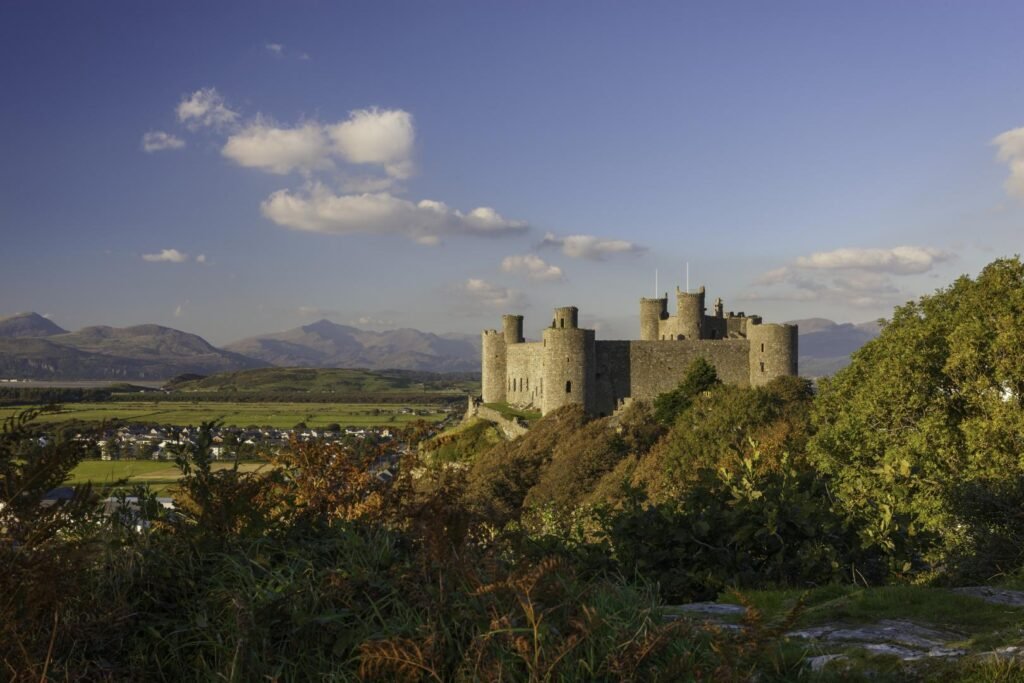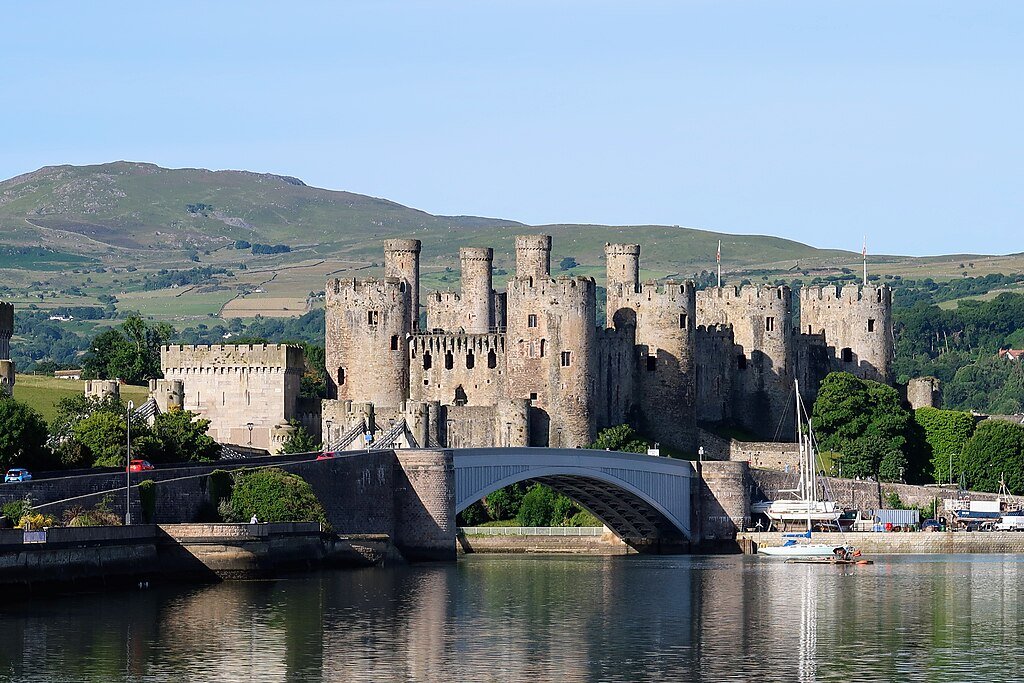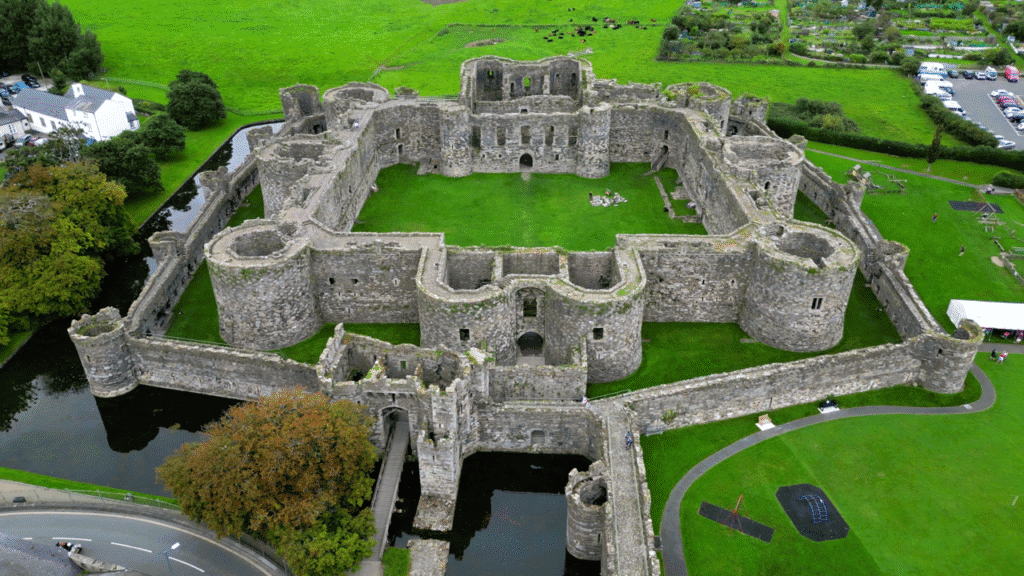
Perched on a rocky crag overlooking the shimmering Irish Sea, Harlech Castle stands as a testament to Wales’ storied past and rugged beauty. This UNESCO World Heritage Site, located in the charming town of Harlech in Gwynedd, North Wales, is more than just a medieval fortress; it’s a window into the turbulent history of the British Isles, a beacon of Welsh resilience, and a must-visit for anyone exploring the UK. Whether you’re a family seeking an educational day out, a couple craving a romantic escape with breathtaking views, or a solo traveller chasing history and adventure, Harlech Castle delivers. Let’s dive into why this iconic castle should be at the top of your UK travel list, and how it can anchor an unforgettable journey through Wales.
A Brief History of Harlech Castle
Harlech Castle’s story begins in the late 13th century, during a time of conquest and rebellion. Built between 1282 and 1289 by King Edward I of England as part of his “Iron Ring” of castles to subdue the Welsh, Harlech was a masterpiece of military engineering. Designed by the renowned Savoyard architect James of St George, the castle was constructed at a cost of £8,190, a modest sum for such an imposing structure. Its concentric “walls within walls” design, inspired by Crusader fortresses, made it a formidable stronghold, with a massive gatehouse, four towering corner turrets, and a unique “Way from the Sea”, a 108-step fortified stairway that allowed supplies to reach the castle by ship during sieges.
Over the centuries, Harlech played a starring role in some of Britain’s most dramatic conflicts. It withstood a siege during the Welsh revolt of Madog ap Llywelyn in 1294–95, only to fall to the charismatic Welsh leader Owain Glyndŵr in 1404. Glyndŵr made Harlech his residence and military headquarters, holding it until English forces, led by the future Henry V, recaptured it in 1409. During the Wars of the Roses (1455–1487), Harlech became a Lancastrian stronghold, enduring a seven-year siege, the longest in British history, from 1461 to 1468, inspiring the rousing anthem “Men of Harlech.” In the English Civil War (1642–1647), it was the last Royalist fortress to surrender to Parliamentarian forces, marking the end of the war’s first phase.
Today, Harlech Castle is a beautifully preserved ruin managed by Cadw, the Welsh Government’s historic environment service. Its designation as part of the UNESCO World Heritage Site “Castles and Town Walls of King Edward in Gwynedd” alongside Beaumaris, Conwy, and Caernarfon underscores its status as one of Europe’s finest examples of medieval military architecture.
Why Visit Harlech Castle? Key Facts and Figures
Harlech Castle isn’t just a historical relic; it’s a vibrant tourist destination that draws thousands of visitors annually. According to Cadw, the castle welcomed over 70,000 visitors in 2024, making it one of the most popular historic sites in North Wales. Its appeal lies in its dramatic setting, perched 200 feet above the Irish Sea with panoramic views of Snowdonia National Park and its rich history, which resonates with visitors of all ages.
- Type: Concentric stone fortress
- Location: Harlech, Gwynedd, North Wales
- Construction Period: 1282–1289
- Historical Significance: Key stronghold in the Welsh Wars, Wars of the Roses, and English Civil War
- UNESCO Status: Part of the “Castles and Town Walls of King Edward in Gwynedd” World Heritage Site
- Visitor Numbers: Approximately 70,000 annually (2024 data)
- Accessibility: Ground-level areas are wheelchair-accessible; upper walls and towers require climbing steep, uneven steps
- Dog Policy: Dogs on short leads are welcome at ground level and in the outdoor café area
Harlech’s popularity reflects a broader trend in UK tourism: a growing interest in heritage travel. Visitors are increasingly drawn to sites that blend history, architecture, and natural beauty, and Harlech ticks all these boxes. Its proximity to other Welsh attractions, such as Snowdonia and the Cardigan Bay coastline, makes it a perfect anchor for a broader exploration of North Wales.
Must-Visit Attractions Near Harlech Castle
Harlech Castle is the crown jewel of Gwynedd, but the surrounding area is brimming with attractions that make it easy to craft a memorable itinerary. Here are some highlights within a short drive or walk:
Harlech Beach
Just a 10-minute walk from the castle, Harlech Beach is a sweeping expanse of golden sand backed by dunes and the Morfa Harlech Nature Reserve. Perfect for families, it offers shallow waters for paddling, kite-flying, and beachcombing. History buffs might spot the remnants of a World War II plane wreckage, adding a touch of intrigue.
Royal St. David’s Golf Club
A five-minute walk south of the castle, this championship golf course is one of the UK’s finest links courses, with stunning views of Harlech Castle and Snowdonia. It’s a great option for couples or solo travellers looking to combine history with leisure.
The Two Kings Statue
Located on the south side of Harlech Castle, this bronze statue commemorates the legend of Branwen from the Mabinogi, a collection of ancient Welsh tales. Unveiled in 1984, it depicts two figures on horseback and is a quick, photogenic stop for visitors.
Llanfair Slate Caverns
A 10-minute drive south, these caverns offer self-guided tours through nine underground chambers, revealing the history of Wales’ slate industry. It’s a family-friendly activity that pairs well with a castle visit.
Portmeirion Village
A 15-minute drive away, this whimsical Italianate village is a surreal contrast to Harlech’s rugged history. Built by Sir Clough Williams-Ellis, it’s famous for its colourful architecture and as the filming location for the 1960s TV series The Prisoner. Ideal for couples and solo travellers seeking a unique experience.
Ffestiniog & Welsh Highland Railways
About 10 miles south in Porthmadog, this historic narrow-gauge railway offers scenic rides through Snowdonia’s mountains and valleys. It’s a hit with families and train enthusiasts alike.
Travel Tips for Visiting Harlech Castle
Planning a visit to Harlech Castle is straightforward, but a few tips can make your experience even better:
- Opening Times: The castle is open daily, with hours varying by season:
- March–June and September–October: 9:30 AM–5:00 PM
- July–August: 9:30 AM–6:00 PM
- November–February: 10:00 AM–4:00 PM (closed Sundays, except July–August: 11:00 AM–4:00 PM)
- Closed December 24–26 and January 1
- Last admission is 30 minutes before closing.
- Ticket Prices (as of 2025):
- Adult: £10.00
- Family (2 adults + up to 3 children): £32.00
- Juniors (5–17), students, and military: £7.00
- Seniors (65+): £9.00
- Under 5s and Cadw members: Free
- Disabled visitors and companions: Free
- English Heritage and Historic Scotland members: 50% discount
- Booking: Pre-booking is recommended via the Cadw website to secure your time slot, especially during peak summer months.
- Accessibility: The visitor centre and ground-level areas are accessible with ramps and automatic doors. However, the castle’s upper walls and towers involve steep, uneven steps, making them unsuitable for wheelchair users or those with mobility issues. Accessible toilets and a portable induction loop are available.
- Family-Friendliness: Harlech is great for kids, with an on-site exhibition that brings the castle’s history to life through videos and displays. The “floating” footbridge, added in 2015, is a fun way to enter the castle, mimicking the original drawbridge. Dogs on leads are welcome at ground level, making it pet-friendly for families.
- When to Go: Summer (July–August) offers the best weather and extended hours, but it’s also the busiest time. Spring (March–June) and autumn (September–October) provide milder weather and fewer crowds, ideal for photography and relaxed exploration. Winter visits are quieter but colder, with shorter hours.
- Practical Advice:
- Wear sturdy shoes for the uneven terrain and steep steps.
- Bring a windproof jacket, as the clifftop can be breezy.
- Arrive early to secure parking, as the castle’s pay-and-display car park is small (£1/hour). A larger long-stay car park, Bron y Graig, is a 7-minute walk away.
- Check Cadw’s social media for weather-related closures, as high winds can affect access to upper areas.
Suggested Itineraries: Exploring Harlech and Beyond
Harlech Castle is a perfect base for exploring North Wales’ rich history and natural beauty. Here are two themed itineraries to suit different travellers:
One-Day Family Adventure
- Morning: Start at Harlech Castle (1.5–2 hours). Explore the visitor centre’s exhibition, walk the “floating” footbridge, and climb the walls for panoramic views. Kids will love imagining medieval battles.
- Lunch: Head to Y Branwen Hotel, a short walk from the castle, for family-friendly pub grub like fish and chips or burgers.
- Afternoon: Spend 2–3 hours at Harlech Beach, where kids can play in the shallow waters or explore the dunes. Visit the Two Kings Statue en route for a quick photo.
- Evening: Drive 10 minutes to Llanfair Slate Caverns for a self-guided tour (1 hour). End the day with dinner at The Castle Restaurant, known for its hearty Welsh dishes.
Three-Day Romantic Coastal Escape
- Day 1: Arrive in Harlech and visit the castle in the morning (1.5 hours). Stroll hand-in-hand along the walls, soaking in views of Snowdonia and Cardigan Bay. Lunch at Cemlyn Tea Shop, a cosy spot for homemade cakes. Spend the afternoon at Harlech Beach, followed by a sunset walk on the Branwen Walk, a 2-mile circular trail linking the castle and town. Dine at The Plas Restaurant for upscale Welsh cuisine.
- Day 2: Drive 15 minutes to Portmeirion Village for a morning of exploring its colourful architecture and gardens (2–3 hours). Enjoy lunch at the village’s Castell Deudraeth Brasserie. In the afternoon, visit the Royal St. David’s Golf Club for a relaxed game or a scenic walk. Return to Harlech for dinner at Y Branwen Hotel’s restaurant.
- Day 3: Take a 20-minute drive to Porthmadog for a ride on the Ffestiniog & Welsh Highland Railways (2–3 hours). Stop for lunch at Spooner’s Café in Porthmadog. Spend the afternoon exploring the nearby town of Barmouth, with its sandy beach and charming high street. Return to Harlech for a final night at a local B&B.
Where to Eat and Stay Near Harlech Castle
Where to Eat
- The Castle Restaurant: Located near the castle, this spot serves traditional Welsh dishes like lamb cawl and local seafood, with castle views. Expect mains from £12–£18.
- Y Branwen Hotel: A family-friendly pub with a varied menu, including vegetarian and vegan options. Try the Welsh beef burger (£14) or Sunday roast (£16).
- Cemlyn Tea Shop: Perfect for afternoon tea or light lunches, with homemade scones and sandwiches (£6–£10). Its cosy atmosphere is ideal for couples.
- The Plas Restaurant: A short walk from the castle, this upscale eatery offers dishes like pan-seared scallops and Snowdonia lamb (£18–£25). Book ahead for dinner.
- Spooner’s Café (Porthmadog): A 15-minute drive away, this railway-themed café is great for families, serving hearty breakfasts and sandwiches (£8–£12).
Where to Stay
- Byrdir House: A charming B&B in Harlech with sea views and cosy rooms. Rates start at £90/night for a double, including breakfast. Ideal for couples.
- Merthyr Farm Campsite: A family-friendly site with stunning views of Snowdonia and the coast. Pitches start at £20/night; glamping pods available from £50/night.
- Castle Cottage: A boutique guesthouse near the castle, offering stylish rooms and a renowned restaurant. Doubles from £120/night, perfect for romantic getaways.
- Gwrach Ynys Country Guest House: A 10-minute drive from Harlech, this rural retreat offers spacious rooms and home-cooked breakfasts. Doubles from £100/night.
- Portmeirion Hotel: For a splurge, stay 15 minutes away in Portmeirion Village. This luxurious hotel offers sea-view rooms from £180/night, ideal for a special occasion.
Seasonal Events and Special Experiences
Harlech Castle comes alive with events that enhance its historical charm:
- Medieval Life Skills (Summer): Cadw hosts workshops where visitors can try archery, medieval crafts, and storytelling. Great for families, these events run in July and August.
- The Time of Legends (Summer): Storytelling sessions bring Welsh myths, like the tale of Branwen, to life within the castle walls. Check Cadw’s website for dates.
- Harlech Triathlon (June): A local event combining swimming, cycling, and running, with the castle as a stunning backdrop. Spectators can enjoy the festive atmosphere.
- Christmas at the Castle (December): The castle hosts festive markets and carol evenings, with mulled wine and local crafts. Perfect for a winter visit.
- Knight Battles (August): Reenactments of medieval battles, complete with armoured knights, draw crowds. Tickets often sell out, so book early via Cadw.
For a unique experience, visit during the Harlech Arts Festival (September), which features local music, art, and theatre in venues around town, including Theatr Harlech. Solo travellers might enjoy guided history tours offered by Cadw, which delve deeper into the castle’s sieges and architecture.
Exploring Broader UK Travel Themes
Harlech Castle is a gateway to exploring the UK’s rich tapestry of castles and historic sites. Wales alone boasts over 600 castles, from the grand Caernarfon to the romantic Castell Coch near Cardiff. Pair a visit to Harlech with other Edward I castles like Conwy or Beaumaris for a “Ring of Iron” tour, showcasing medieval military might. Beyond Wales, the UK’s castle trail extends to England’s Dover Castle, Scotland’s Edinburgh Castle, and Northern Ireland’s Carrickfergus Castle, each offering unique insights into Britain’s past.
The castle also highlights the UK’s trend toward immersive heritage experiences. Many historic sites now offer interactive exhibitions, reenactments, and digital guides, making history accessible to all ages. Harlech’s visitor centre, with its video displays, is a prime example. This trend extends to sites like York’s Jorvik Viking Centre or London’s Tower of London, where storytelling brings the past to life.
For nature lovers, Harlech’s proximity to Snowdonia National Park ties into the UK’s growing popularity as an outdoor destination. From hiking in the Lake District to surfing in Cornwall, the UK offers diverse landscapes that complement its historical attractions. Harlech’s blend of history and scenery makes it a microcosm of what makes UK travel so special: the chance to step back in time while surrounded by breathtaking natural beauty.
Conclusion: Why Harlech Castle Should Be Your Next Stop
Harlech Castle is more than a pile of ancient stones; it’s a living piece of history that captures the imagination. Its dramatic clifftop setting, gripping tales of sieges and rebellions, and proximity to North Wales’ natural wonders make it a perfect destination for families, couples, and solo adventurers. Whether you’re standing on the battlements gazing at Snowdonia, strolling along Harlech Beach, or savouring a Welsh lamb dinner, Harlech offers a taste of the UK’s rich heritage and timeless charm. Plan your visit, pack your camera, and let Harlech Castle be the start of your Welsh adventure.


